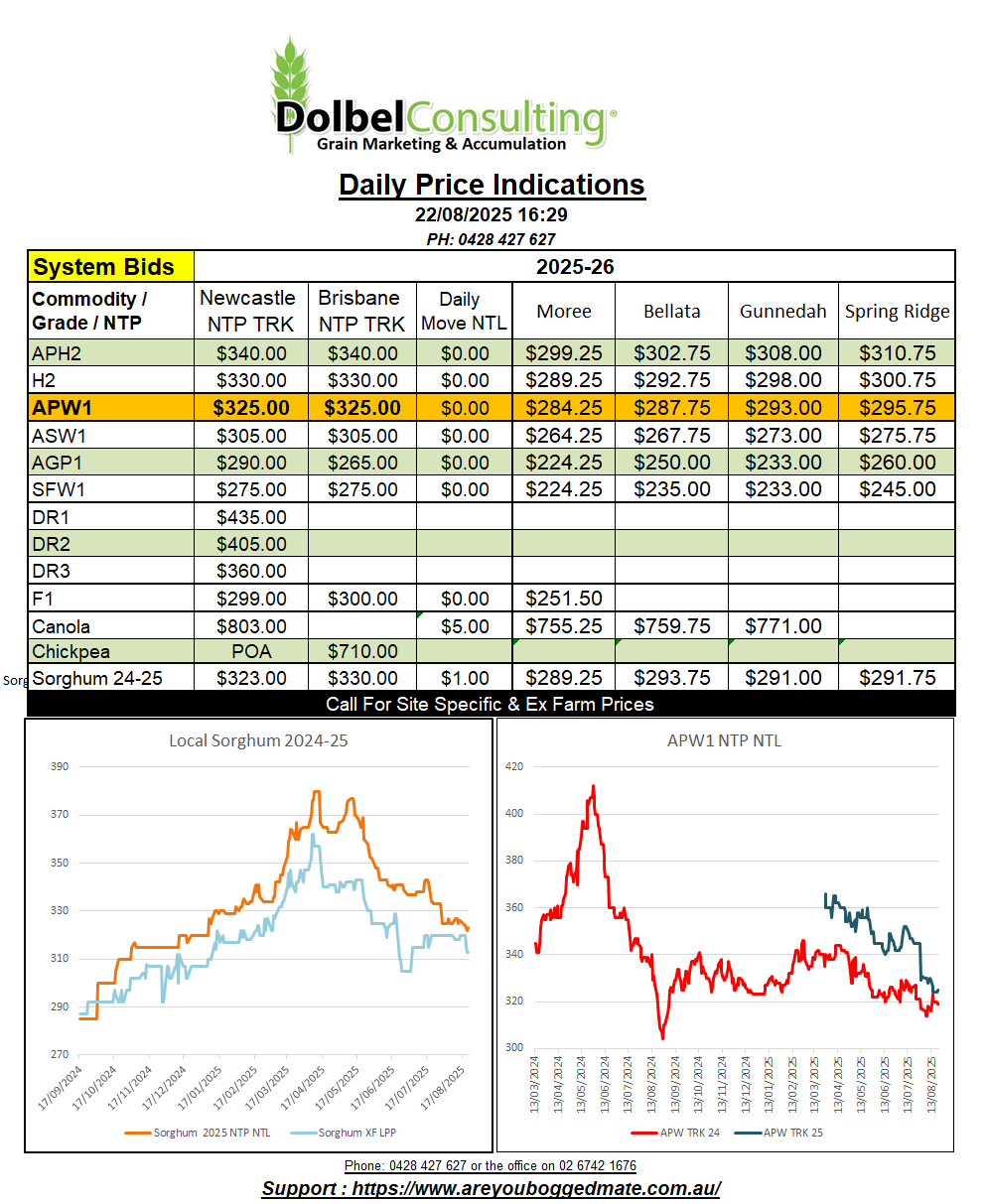22/8/25 Prices

Punters, maybe a day late, jumped in on Chicago corn futures last night. Good US weekly exports, last week, and a couple of good flash sales this week gave the market a sniff of optimism even though the US corn crop is projected to be significantly bigger year on year. The USDA reports sales of 112.6 million bushels of corn last week, to the rest of the modern world this is equivalent to about 2.86mt. Prior to the release of the report the upper end of expectations was 2mt, so the USDA number was significantly higher than expected and fueled a little buying in US corn futures.
Higher corn futures spilled over in the sorghum market. FOB offers for September sorghum out of the Gulf gained a dollar or so but values CnF China were generally flat to lower.
The US is expecting to see an increase in competition from Brazil, who have just about completed harvesting their own large corn crop. At 132mt, according to the August WASDE, the Brazilian crop is large. CONAB predict it to be even bigger than the USDA, at 137mt, if realised this will be a Brazilian record. So why the rally in US corn futures you ask. Brazil has increased domestic demand for ethanol and it also has a few logistics issues when it comes to exports. Soybeans are currently taking up a lot of port space. We also have low international prices, China has not been buying big licks of corn. Better Chinese production is expected to see their domestic stockpiles continue to grow.
The old saying “low prices fix low prices” is starting to ring out for the Brazilian market. Producers their are happy to carry product instead of taking current values. The use of silo bags there has increased significantly this year. The market may need to rally to attract sellers.
What does this mean for the USA. Well it could spell a longer term at stagnated values, the longer it takes to sell corn, US or Brazilan, the bigger the chance that more corn will makes it’s way to the ending stocks number and be carried in to the new season, increasing total availability. At some stage sales will need to be made. The timing of this grain hitting the market is what may hurt the US farmer, will it all come to the world market at once ?
As expected local new crop wheat bids did not track US futures higher, instead we saw weaker basis to Chicago. Basis fell from +51c/bu on the previous day to +43c/bu yesterday. This continues to signal the trades intention to keep local prices more in line with volatility in international cash values as opposed to tracking the volatility of US wheat futures. Kind of makes sense given the detachment of wheat futures to the international cash market at times.
I’m looking to make an international wheat price cash movement indicator.
Looking at international cash values I’ve simply added together the day to day move after the conversion of 8 of the major wheat export grades from the USA, Canada, Europe, Argentina, Russia and Ukraine and averaged those moves. The conversion takes the wheat value from the destination port, converts it to USD, ships that wheat to a common Asian consumer to determine a CnF price. Takes that price back to a Newcastle port equivalent price and then converts that price to an equivalent up country price here in AUD/tonne and compares that price to the previous days.
It’s a little simplistic but takes the day to day change in the AUD into account, the day to day change in origin currency and USD into account, the day to day change in FOB wheat origin into account, and changes in ocean freight rates, on a less regular basis, into account. It’s a basic way of saying what value we need to be to compete into X market without taking other factors like milling differences, logistic and insurance deals, and general market grease into account.
After all that, you come up with a number representing an “average” move in generic cash wheat values. Last night that move was +AUD$2.09/t. So basically we have a futures change to compare local wheat movement with, last night that was AUD$1.47/t, and a world cash “average” price movement. So to see a change of less than either of these would indicate that, APW for instance, is then cheaper on the international market than it was the previous day.
